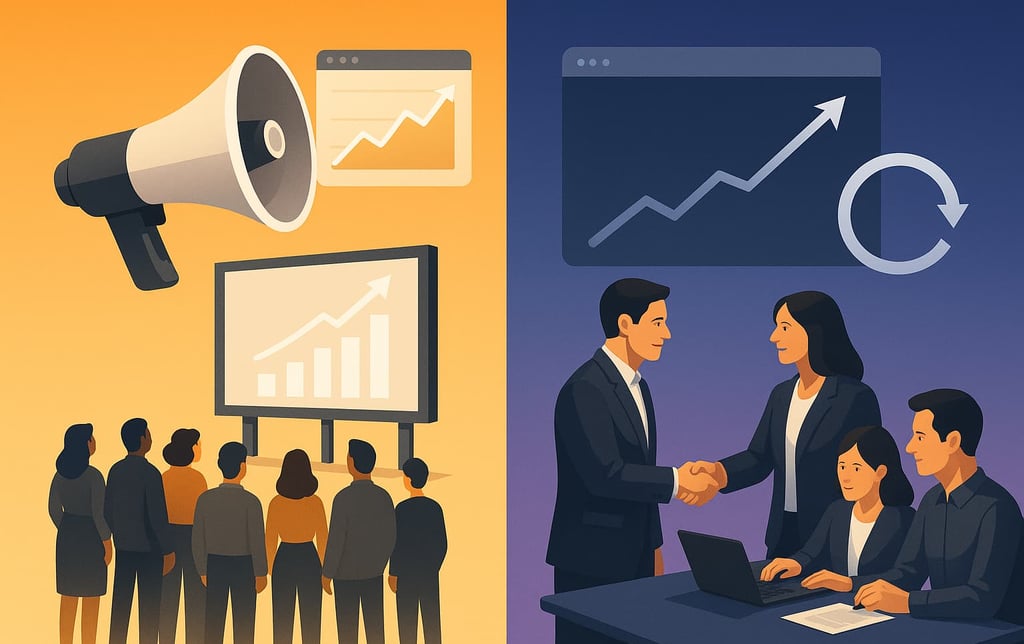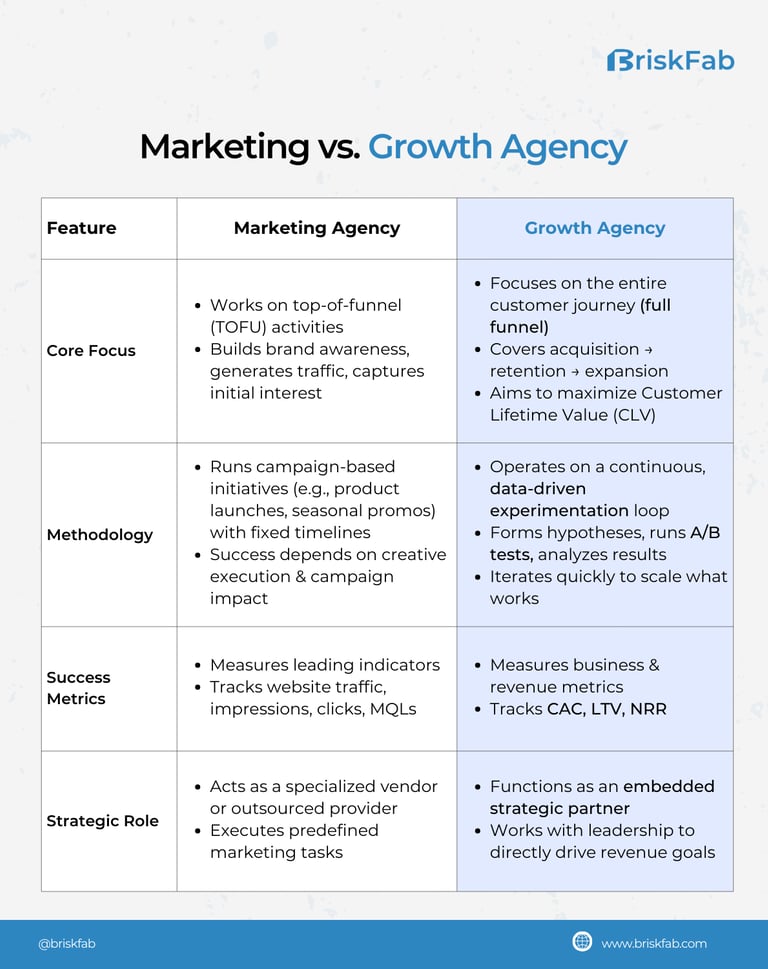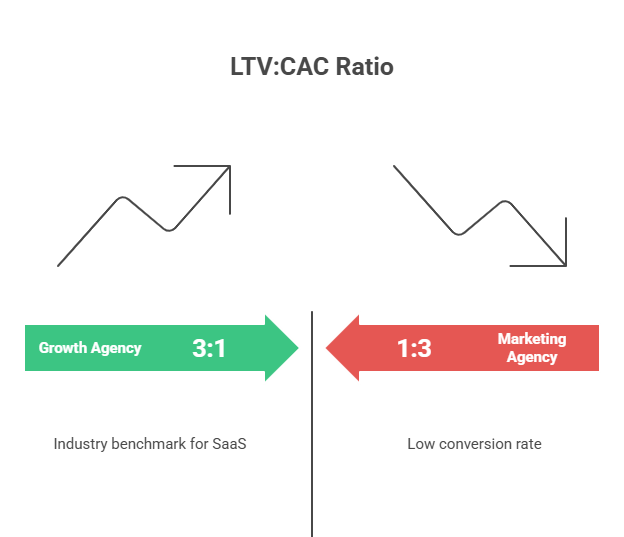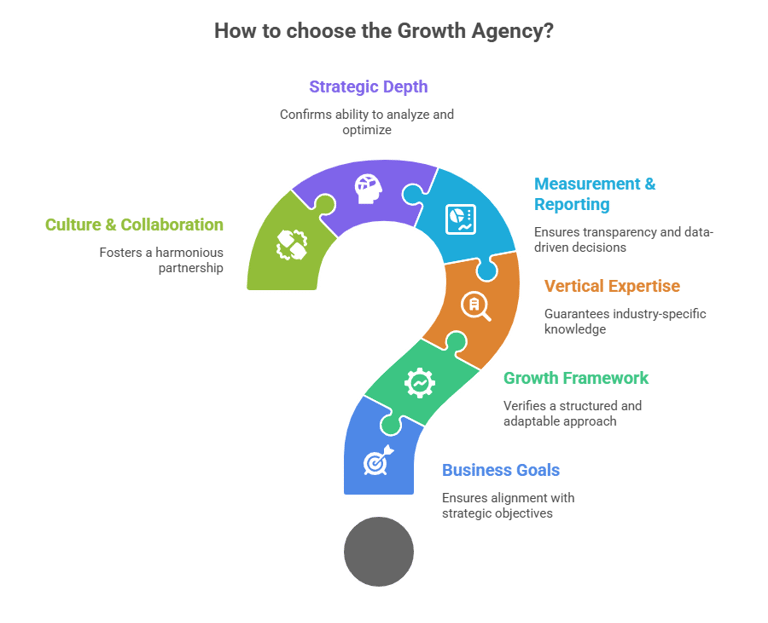Growth Agency vs Marketing Agency: The B2B Tech Leader’s Playbook for 2025
SAASGROWTH
8/14/20255 min read


TL;DR
Marketing agencies focus on awareness and activity metrics.
Growth agencies own the entire funnel – acquisition, retention, expansion.
The difference: one sells activities, the other sells outcomes.
In 2025’s B2B SaaS landscape, sustainable ARR growth comes from aligning marketing, sales, and product into a single revenue engine.
This guide shows the difference, the metrics that matter, and how to choose the right partner.
Growth Agency vs. Marketing Agency: A Detailed Comparison
Ever seen your campaign dashboard light up with clicks, impressions, and MQLs – but when you check the P&L, the needle hasn’t moved?
It’s not bad luck.
It’s a model problem.
Most companies still buy marketing as a set of activities – ads, content, SEO – without asking whether those activities actually lead to revenue.
According to HubSpot’s 2025 State of Marketing, demonstrating ROI and being truly data-driven are among the top challenges for marketing leaders worldwide.
That’s where the Growth Agency model comes in – built for full-funnel accountability and scaling what moves profit, not just traffic.


The Metrics That Separate the Two
Marketing Agency Metrics – Activity Focus
Impressions & Reach → Eyeballs, not wallets.
Clicks & Traffic → Attention, not necessarily action.
MQLs → Early interest, but often not sales-ready.
Problem: High activity with low conversion = marketing as an expensive hobby.
Growth Agency Metrics – Revenue Focus
Customer Acquisition Cost (CAC) → How much to get a paying customer? Goal: lower it sustainably.
Lifetime Value (LTV) → Revenue per customer over their lifetime. Goal: increase it.
LTV:CAC Ratio → Industry benchmark for SaaS is ~3:1 or higher for scalable growth.
Net Revenue Retention (NRR) → Are customers staying and spending more? High NRR = healthy SaaS economics.
Mindset shift: Your marketing report should look like your CFO’s report — profitability over popularity.


Why Your Business Needs a Growth-First Mindset
Switching to a growth agency isn't just a change in vendor; it's a change in philosophy. Here’s why it’s essential for scaling in 2025.
They Align Marketing with Business Outcomes
A growth agency doesn't care about vanity metrics. They obsess over the same numbers as your CFO: Customer Acquisition Cost (CAC), Lifetime Value (LTV), and churn. They don't just generate leads; they build entire revenue ecosystems designed to be profitable.
They Are Adaptable & Agile
The market changes overnight. A growth agency is built for this. Instead of being locked into a six-month content plan, they run weekly or bi-weekly experiments. If an ad channel stops working, they pivot. If a new opportunity emerges, they seize it. Agility is their default setting.
They Focus on the Full Funnel
This is the most important part. A traditional agency's job stops when a lead comes in. A growth agency knows that's where the real work begins. They understand that it can cost five times more to acquire a new customer than to retain an existing one. That's why they work across the entire customer journey, from first click to repeat purchase and referral.
How to Choose the Right Digital Growth Agency: A 6-Point Checklist
Finding the right growth partner is a huge decision. It’s not about flashy presentations; it’s about finding a team that can actually move the levers of your business.
Here’s a structured checklist to guide you.
1. Start With Your Business Goals (Not Marketing Goals)
Before you talk to anyone, define what you actually want. Is it accelerating your sales pipeline? Expanding into a new market? Reducing customer churn?
A great growth agency will ask about your business goals first. If they jump straight to talking about SEO or ad campaigns, they're still thinking like a traditional marketing agency.
2. Evaluate Their Growth Framework
The best agencies have a repeatable, data-backed framework, not a collection of one-off tactics.
Ask them: "How do you connect marketing, sales, and product into one strategy?"
Look for evidence of experimentation—A/B testing, cohort analysis, and fast iteration cycles. This proves they can adapt. At BriskFab, for example, we run every client through our Revenue Engine Audit to map their entire funnel and find the highest-impact growth levers first.
3. Look for Vertical Expertise
This is non-negotiable. If you're a B2B SaaS company, don’t hire an agency that specializes in e-commerce.
An agency with deep industry familiarity already knows your market, your buyers, and the channels that work. They'll deliver results faster because they aren't learning on your dime.
4. Scrutinize How They Measure & Report
Growth without clear attribution is just expensive guesswork. They should be obsessed with metrics that matter:
CAC (Customer Acquisition Cost)
LTV (Customer Lifetime Value)
MQL → SQL conversion rates
Customer Churn & Expansion rates
Ask for a sample report. Even better, ask if they provide a real-time dashboard. Transparency is key.
5. Test Their Strategic Depth
Here's a pro move: ask them to do a mini-audit of your current funnel before you sign anything.
Give them access to your analytics and see what they find. Can they spot bottlenecks you've missed? Do they ask smart questions about your unit economics? A great agency can connect brand positioning and channel strategy to a balance sheet in one conversation.
6. Check for a Culture & Collaboration Fit
You’re not hiring a vendor; you’re embedding a partner into your team. Growth is a long-term game, and friction will kill momentum.
Ask about their communication cadence, what collaboration tools they use (like Slack or Asana), and how they handle feedback. You want a partner who feels like an extension of your own team.


Conclusion: Are You Buying Activities or Outcomes?
The choice between a marketing agency and a growth agency comes down to one question: What are you trying to buy?
If you need a beautiful brand, a flashy ad campaign, or someone to manage your social media, a traditional marketing agency is a great choice. They are experts in awareness.
But if you’re ready to build a scalable, predictable engine that converts that awareness into revenue, that's the realm of a growth agency.
At BriskFab, we bridge that gap. We believe in powerful storytelling and creative branding – but we ensure it's all backed by a full-funnel, data-driven system engineered to move the metrics that matter to your CEO.
Frequently Asked Questions (FAQs)
1. Can a marketing agency just "become" a growth agency?
It’s tough. True growth requires a different DNA, deep skills in data analytics, experimentation, funnel optimization, and product insights, which go far beyond traditional creative and campaign management.
2. How long does it take to see results with a growth agency?
You should see initial "quick wins" and data clarity within the first 1-2 months. However, true, compounding growth from scaled experiments typically emerges over 4-6 months as the engine gets dialed in.
3. Are growth agencies more expensive than marketing agencies?
Their retainer might seem higher upfront, but they are almost always more cost-efficient in the long run. Their focus on retaining customers and increasing lifetime value means your marketing dollars generate a much higher, more sustainable ROI.
✅ Ready to see your growth levers?
Get a Free Revenue Engine Mini-Audit – we’ll map your funnel, score your CAC, LTV, NRR, and show you the 3 experiments that could unlock your next 20% revenue lift.
